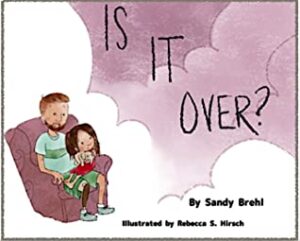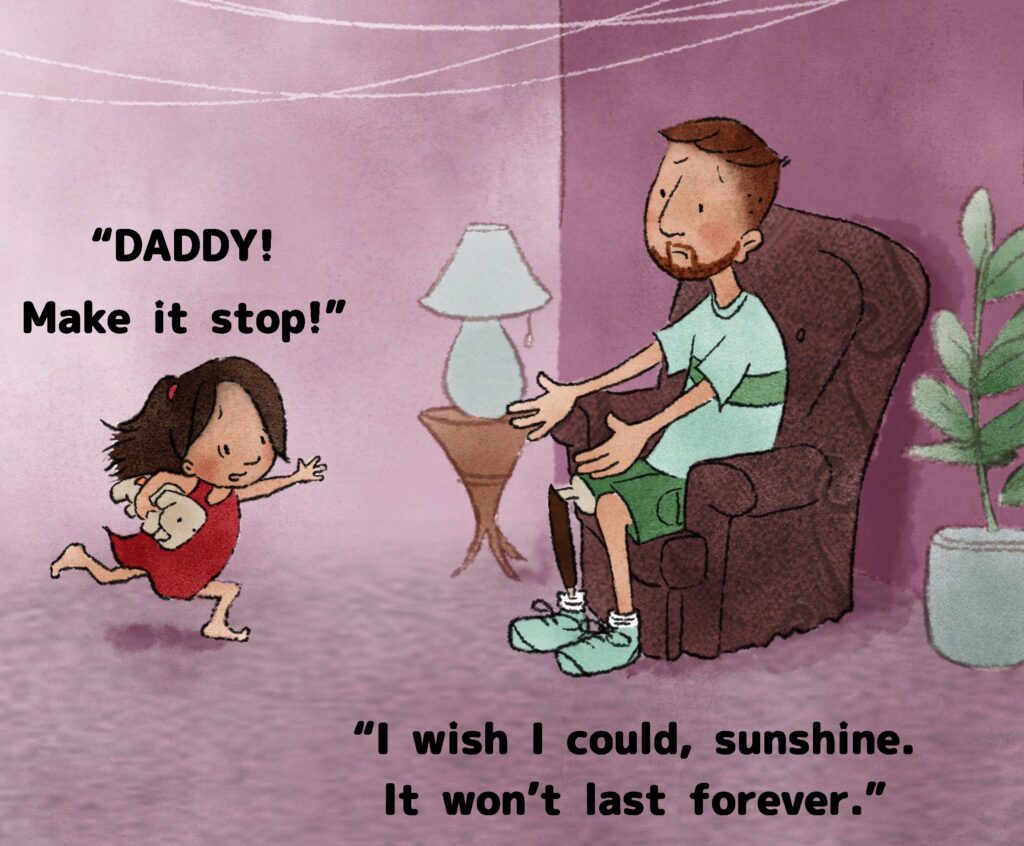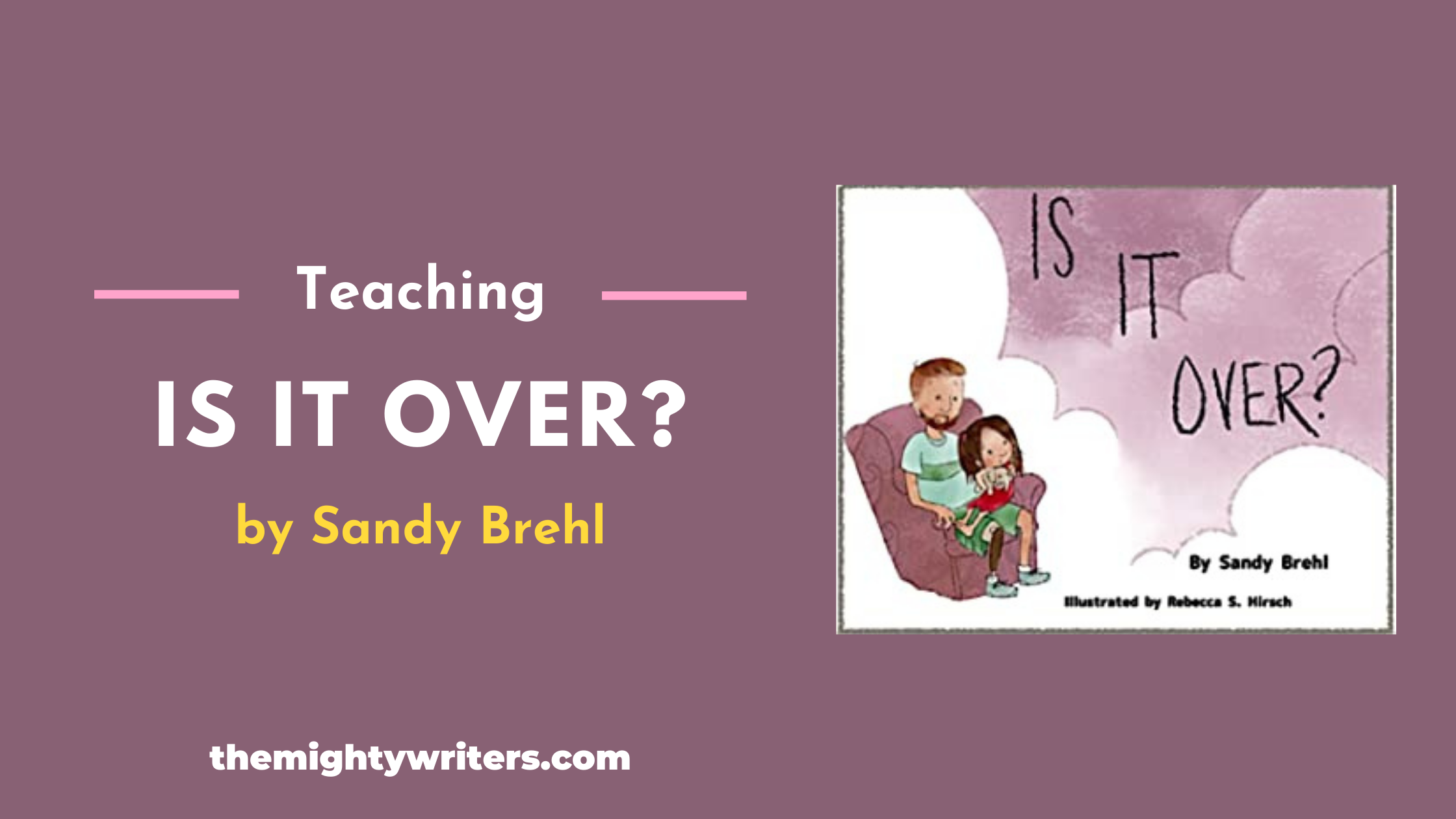A Note to Readers
I am so thrilled to welcome my friend and critique partner Sandy Brehl to the blog to talk about her new picture book, Is It Over? You may remember that Sandy stopped by the blog earlier this year to talk about The Joy of Sharing Picture Books. In both posts, Sandy offers helpful information for those of you who work with young readers and are looking for ways to combine picture book stories with classroom activities. Is It Over? offers so many wonderful opportunities for you to interact with young people around storms, storytelling, and the power of relationships.
And bonus! Sandy is offering a signed copy of the book to one lucky reader!
Enjoy!
Rochelle
Teaching Is It Over?
What do you hope your readers will take away from the book, Is It Over?
 My answer to that depends on who the reader/audience is.
My answer to that depends on who the reader/audience is.
At the most basic level, a picture book should engage, entertain, and invite repeated readings. In this case, the amazing illustrations by Rebecca S. Hirsch accomplish that for us. She captured the characters and the heart of the story, then revealed them far beyond my words, exploring the power of empathy, love, and storytelling to overcome fear.
On a more specific level, this story began (years ago) by addressing the common fear of thunderstorms among young children. My earliest memories of Midwest thunderstorms (and most things in life) involve storytelling by my parents, grandparents, and friends. Some said that thunder was the sound of angels bowling, and that lightning flashes were strikes and cheers. Some said the angels were playing a drum concert, and the flashes were stage-light effects. Some stories I heard later in life included ghosts (or saints) riding the clouds in bumper-car style or medieval jousts. I recently read someone’s memory of being told that lightning is God taking pictures of US, so we should smile up at the sky during a storm.
That last one is a very clever example of the intent behind such stories: to distract, to explain, and to reassure. I actually enjoyed storms as a child, so I welcomed them as much for their atmosphere and excitement as for the storytelling they launched. But as a teacher, and within my family, I wanted to offer relief from that heart-pounding terror I often recognized in little ones.
I hope that young audiences will not only find this particular story to be comforting, but will recognize their own storytelling power. At the earliest ages, little people have a natural impulse to empathize, but fear can override that with a fight/flight reaction. I was eager to encourage the natural response to run to a trusted adult, but also to nudge children past that initial response, to become aware of and care about the feelings of others—empathy.
Picture books allow adults and children to experience lives within stories together, vicariously. In this case, I hope that the adults who share my book will recognize their own power of storytelling. Some adults still fear storms, whether as a residue of childhood or in response to personal trauma. They often try to deny their fear for the sake of a child. Like puppies or other pets, children are deeply sensitive to strong emotions, as Risa is to Daddy’s fear. I hope this story might provide a gentle nudge to acknowledge that adults, too, may feel fear, providing a model that fear can be managed (or at least endured). This story also reveals that even in the worst circumstances, when not at our best, trusted adults can be counted on for comfort and safety.

During this story’s years-long journey to becoming a book, Daddy emerged as a veteran. Kids today, many more than we may imagine, are connected within families to one or more veterans from our two decades of distant war. Some scars of those experiences are physical, but many more abide in the hearts and minds of those who returned. As the child of a World War II veteran who spoke very little about his experiences until his final years, I was intentional in telling a story that might allow families to open a door to conversations about fear or anxiety. There are many non-military “veterans”, too, those who have survived trauma from other sources but live with the ongoing repercussions. They may find this book to be a springboard for honest and healing conversations.
Wow, I made this sound like an ominous or heavy story, didn’t I? In fact, it is a daddy-daughter story of love, told in very few words with colorful, lighthearted illustrations that celebrate a joyful resolution. Storms always end, don’t they?
As I said, my hope is that both adults and kids will be entertained, comforted, and inspired to imagine stories and share them with those they love.

How might a teacher or librarian use your book in the classroom?
- For young readers/audiences, this book can open a valuable conversation to label and discuss strong emotions: worry, fear, bravery, safety, etc. At young ages, children tend to generalize emotions as “feeling good” or “feeling bad”. Story-based examples, especially with visual cues found in illustrations, can help them refine their understanding of emotions and more clearly describe their own feelings and recognize them in others. With Hirsch’s minimalist but expressive art, we can encourage kids to “mirror” the faces on various pages with their own expressions, then connect that feeling with the times/ways in which that expression occurred in real life. Associating feelings with specific situations can also serve to prompt storytelling or writing.
- Cause-and-effect play an important part in this literal story, allowing for lessons on story structure, character development, and making predictions. Practice in inferring from limited text can also emerge: the only indication that Daddy is a veteran, other than illustrations, is the line: “They (my storm stories) changed while I as a soldier.”
- During the appropriate season or a specific study unit, this story could introduce the topic of exploring weather and storms: predictions/forecasts, thunder/lightning, preparedness kits for severe weather, safe spaces, seasons, weather patterns and climate, etc.
- “Is It Over?” is an expression/feeling often related to things that are unpleasant. This invites some discussions of the relativity of time- what makes it feel so S-L-O-W, or go way too FAST! In that context, discuss how time “feels” different depending on the circumstances (waiting for a holiday, vacation, or birthday compared to the actual event, etc.).
Can you share some exercises a teacher might do with your book?
Oral storytelling is always popular, especially when it comes to nature stories or origin stories. Telling, writing, interviewing others, or researching “storm stories” can spark art, oral sharing, written reports, or further reading. It can also encourage investigations to compare and contrast culturally anchored stories. Some links to sites that provide rich examples of traditional stories from other cultures can be found on my website under the RESOURCES tab.
In the context of time passing, we can measure the distance of a storm, then relate results to how near or far it is, for safety purposes. This not only distracts, but also allows estimates on how soon it may move past us.
Try this informal counting technique:
After you see a flash of lightning, count the number of seconds until you hear the thunder. (Use the stop watch or count “One-Mississippi, Two-Mississippi, Three-Mississippi,” etc.) For every 5 seconds the storm is one mile away. Divide the number of seconds you count by 5 to get the number of miles.
For older students this can include a science lesson about the relative speed of light and sound, what is producing them, and how they reach our eyes and ears.
What books pair well with your book?
Storm stories:
Boom! Boom! Boom! Written by Jamie A Swenson and illustrated by David Walker
(Farrar, Strauss, and Giroux, 2013)
Franklin and the Thunderstorm written by Paulette Bourgeois and illustrated by Brenda Clark (Scholastic Books, 1998) A dear old picture book friend, Franklin.
The Story of Lightning and Thunder, by Ashley Bryan (Alladin Paperbacks, 1999)
Waiting Out the Storm, written by JoAnn Early Macken, illustrated by Susan Gaber (Candlewick Press, 2010)
For ELEPHANT Fans:
Elephant and Piggie series, written and drawn by Mo Willems
The Shadow Elephant, by Nadine Robert and Valerio Vidall (Enchanted Lion Books, 2020) An intense but lovely story of about a elephant and an unexpected friend.
Thirsty, Thirsty Elephants, by Sandra Markle with illustrations by
Fabricio Vandenbroeck (Penguin Random House, 2017) An informative and happy-ending non-fiction picture book about elephant herd behavior, based on a true story:
Veteran-Related Picture Books:
Crow Call, by Lois Lowry, illustrated by Bagram Ibatoulline (scholastic Press, 2009)
Fly Away Home, by Eve Bunting, illustrated by Ronald Himler (Clarion Books, 1993)
Hero Mom, by Melinda Hardin, illustrated by Bryan Langdo (Two Lions, 2013)
Tuesday Tucks Me In: The Loyal bond Between a Soldier and His Service Dog, by Luis Carlos Montalvan (Henry Holt Books, 2014)
Emotions/Anxiety/Fear
1, 2, 3, JUMP! By Lisl Detlefsen, illustrated by Madeline Valentine (Roaring book Press, 2019)
The Rabbit Listened, by Cori Doerrfield (Dial Books, 2018)
Ruby Finds a Worry Big Bright Feelings), by Tom Percival (Bloomsbury Children’s books, 2019)
SOAKED! By Abi Cushman (Viking Books for Young Readers, 2020)
Thundercake, by Patricia Polacco. (Puffin Books paperback reprint, 1993)
 About the author: Sandy Brehl is an award-winning author, member of the Wisconsin chapter of SCBWI, and Holocaust outreach educator. Visit her website: https://sandybrehlbooks.com. Find picture book reviews and interviews here: http://unpackingpicturebookpower.blogspot.com
About the author: Sandy Brehl is an award-winning author, member of the Wisconsin chapter of SCBWI, and Holocaust outreach educator. Visit her website: https://sandybrehlbooks.com. Find picture book reviews and interviews here: http://unpackingpicturebookpower.blogspot.com
Is it Over? is Sandy Brehl’s first picture book.
Facebook: Sandy Brehl Author
Twitter: @SandyBrehl and @PBWorkshop
 About the Illustrator. Rebecca S. Hirsch is an illustrator and member of the Wisconsin chapter of SCBWI. She lives with her husband and daughters in Waukesha, You can find her online at: https://www.rhirschillustration.com
About the Illustrator. Rebecca S. Hirsch is an illustrator and member of the Wisconsin chapter of SCBWI. She lives with her husband and daughters in Waukesha, You can find her online at: https://www.rhirschillustration.com
And as rhirschillus on Instagram.


